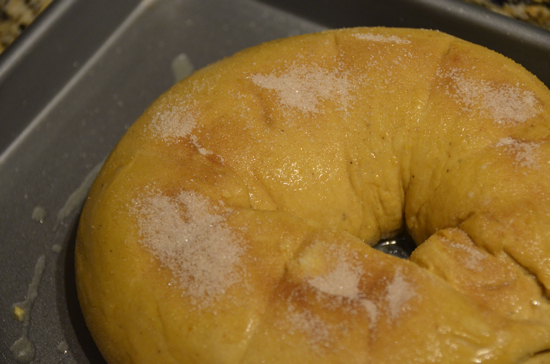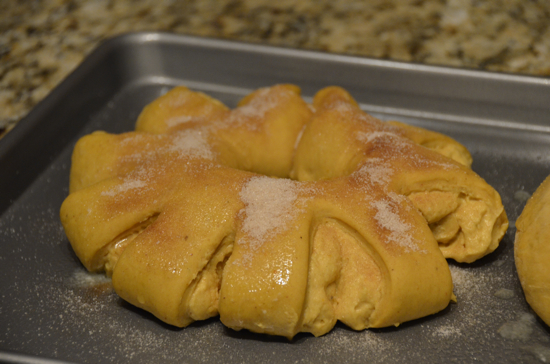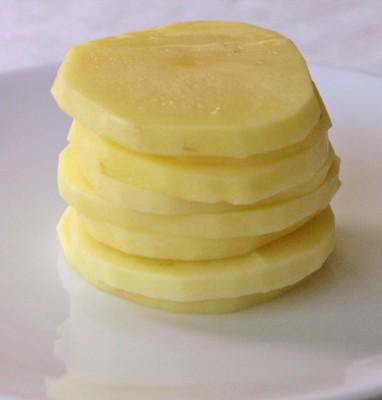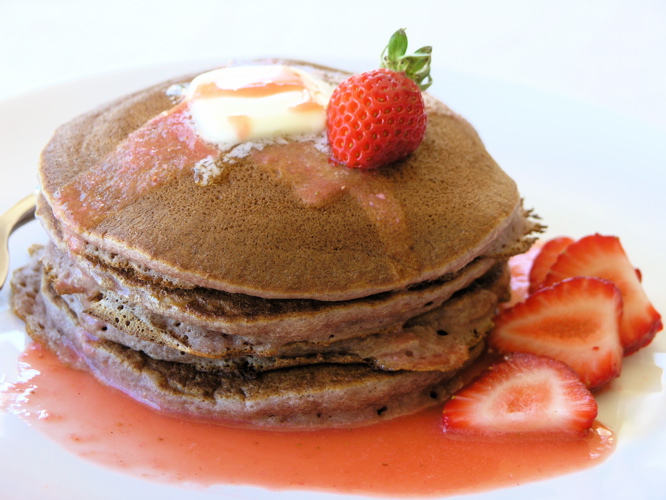[pinterest]

I have been having so much fun baking with yeast this month. Today is no exception. I decided I wanted to make a coffee cake type pastry with icing and filling that would feature fall pumpkin flavors. I grew up with Entenmann’s pastries from the grocery store, and I was looking to emulate their various Danish rings with this recipe.
I ended up constructing this wreath in two ways. One way was a traditional circle. For the other, I cut little slits all the way around before baking it, and the wring came out a little more decorative – though less tidy. Totally up to you for how to make yours, but the recipe does make 2 loaves, so play with it!


The recipe calls for 2 rises. One for the dough and then another one once the dough is stuffed. If you want to refrigerate your dough after stuffing it, you can refrigerate it overnight, then pull it out, let it come to room temperature, rise and then bake it so it comes out of the oven warm just in time for brunch.
I kept this dish nut free because of allergy concerns, but sliced almonds or pecans are a great addition to the topping.

- 1 package dry yeast (2¼ tsp)
- ¼ cup warm water
- 3½ cups all-purpose flour
- ¾ cups canned pure pumpkin
- ½ cup milk
- ¼ cup butter, melted
- 1 Tbsp sugar
- 1¼ tsp salt
- ½ tsp ground nutmeg
- ½ tsp ground ginger
- 1 tsp ground cinnamon
- ¼ tsp ground cloves
- ---
- 2 8oz packages cream cheese
- ½ cup canned pure pumpkin
- 1 cup sugar
- 2 Tbsp butter softened
- 1 tsp cinnamon
- ---
- 1 Tbsp butter, melted
- ¼ cup sugar
- ½ tsp cinnamon
- ---
- 1 cup powdered sugar
- 1 Tbsp milk
- ¼ tsp vanilla
- Dissolve the yeast in warm water in a mug and cover with a plate. Set aside for 5 minutes. When you lift the plate, it should be foamy. If it's not foamy, it means that the yeast is no longer active and you'll have to start over with new yeast.
- In the bowl of a stand mixer, using the dough hook, combine 3 cups of the flour, the pumpkin, milk, melted butter, sugar, salt, nutmeg, ginger, cinnamon and cloves. Once it has taken on a crumbly texture, add the water and yeast mixture and continue mixing with the dough hook until a ball forms. Scrape the sides as necessary to ensure complete mixing. If the dough is sticky and not well-formed, add a Tbsp or so of flour and continue kneading with the dough hook. Knead for 3 minutes on medium speed, adding flour to ensure a springy, well-formed ball.
- Add a tsp of oil to the bowl and knead for 30 seconds. Remove bowl and cover with towel. Set in a warm place and let rise for 45 minutes to an hour until doubled.
- After the dough has risen, punch it down and turn it out onto a floured cutting board. Let rest for 5 minutes, then cut in half.
- To prepare the filling, go back to your stand mixer (wash that bowl), but this time you will use the wire whisk to beat at high speed, the cream cheese, pumpkin, sugar, butter, and cinnamon. Beat for 2 minutes until fluffy.
- Now roll out one ball of dough into a flat rectangle that is about 10x12 inches in size. Spread the cream cheese mixture over the dough leaving space around the edges. The cream cheese will be about ¼ inch thick. Now roll the long side of the dough up to make a tube. Bend the tube into a circle and press the ends together firmly. If you'd like to try cutting slits in the wreath, go ahead and do so. Repeat with the other ball of dough. You will have left over cream cheese mixture. It can be refrigerated for up to 3 days and used as icing on cupcakes.
- Transfer the rings to a cookie sheet or jelly roll pan sprayed lightly with cooking spray. Cover with a cloth and set in a warm place. Allow them to rise for 45 minutes. (Alternatively, you could cover them in plastic and refrigerate them over night before allowing them to come to room temperature and to rise the next morning)
- Preheat the oven to 375˚F.
- Using a spoon, spread melted butter over the tops of both rings. Use the back of the spoon to coat them evenly. Sprinkle cinnamon sugar on top of each ring. Bake for 30 minutes or until golden brown. Let cool on the baking sheet before transferring them to platters.
- Once the rings are cooled, make the icing by stirring together the sugar, milk and vanilla in a bowl with a fork or a wire whisk. If the icing is not going to hold the shape of its drizzle, add more sugar to thicken. Drizzle onto the rings and allow the icing to set for 5-10 minutes before serving.










